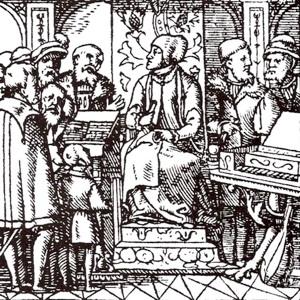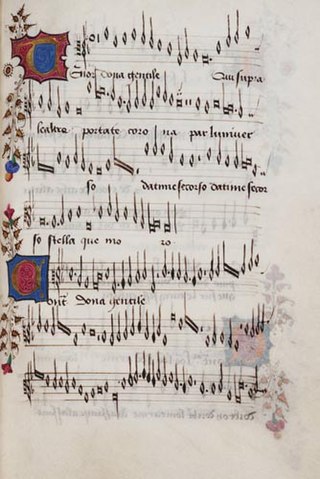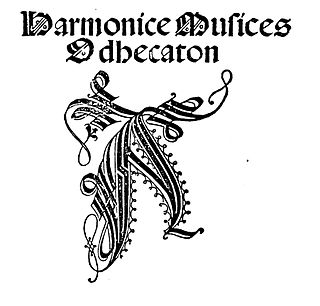Related Research Articles
This article contains information about the literary events and publications of 1501.
A chanson is generally any lyric-driven French song. The term is most commonly used in English to refer either to the secular polyphonic French songs of late medieval and Renaissance music or to a specific style of French pop music which emerged in the 1950s and 1960s. The genre had origins in the monophonic songs of troubadours and trouvères, though the only polyphonic precedents were 16 works by Adam de la Halle and one by Jehan de Lescurel. Not until the ars nova composer Guillaume de Machaut did any composer write a significant number of polyphonic chansons.
Jacques Arcadelt was a Franco-Flemish composer of the Renaissance, active in both Italy and France, and principally known as a composer of secular vocal music. Although he also wrote sacred vocal music, he was one of the most famous of the early composers of madrigals; his first book of madrigals, published within a decade of the appearance of the earliest examples of the form, was the most widely printed collection of madrigals of the entire era. In addition to his work as a madrigalist, and distinguishing him from the other prominent early composers of madrigals – Philippe Verdelot and Costanzo Festa – he was equally prolific and adept at composing chansons, particularly late in his career when he lived in Paris.

TielmanSusato was a Renaissance composer, instrumentalist and publisher of music in Antwerp.

Loyset Compère was a Franco-Flemish composer of the Renaissance. Of the same generation as Josquin des Prez, he was one of the most significant composers of motets and chansons of that era, and one of the first musicians to bring the light Italianate Renaissance style to France.
Jacques Buus was a Franco-Flemish composer and organist of the Renaissance, and an early member of the Venetian School. He was one of the earliest composers of the ricercar, the predecessor to the fugue, and he was also a skilled composer of chansons.

Bernardo Pisano was an Italian composer, priest, singer, and scholar of the Renaissance. He was one of the first madrigalists, and the first composer anywhere to have a printed collection of secular music devoted entirely to himself.
Pierre Attaingnant or Attaignant was a French music publisher, active in Paris. He was one of the first to print music by single-impression printing, greatly reducing the labor involved, and he published music by more than 150 composers.

Music publishing is the business of creating, producing and distributing printed musical scores, parts, and books in various types of music notation, while ensuring that the composer, songwriter and other creators receive credit and royalties or other payment. This article outlines the early history of the industry.
Johannes Ghiselin (Verbonnet) was a Flemish composer of the Renaissance, active in France, Italy and in the Low Countries. He was a contemporary of Josquin des Prez, and a significant composer of masses, motets, and secular music. His reputation was considerable, as shown by music printer Ottaviano Petrucci's decision to print a complete book of his masses immediately after his similar publication of masses by Josquin – only the second such publication in music history.

The Harmonice Musices Odhecaton is an anthology of polyphonic secular songs published by Ottaviano Petrucci in 1501 in Venice. It is the first book of polyphonic music ever to be printed using movable type. The Odhecaton was hugely influential both in publishing in general and in dissemination of the Franco-Flemish musical style.

Andrea Antico was a music printer, editor, publisher and composer of the Renaissance born in the Republic of Venice, of Istrian birth, active in Rome and in Venice. He was the first printer of sacred music in Rome, and the earliest competitor of Venetian Ottaviano Petrucci, who is regarded as the first significant music printer.
Johannes de Quadris (Quatris) was an Italian composer of the early Renaissance. He was one of the first composers of polyphony associated with the basilica of St. Mark's in Venice, and the earliest known composer to write a polyphonic setting of the Magnificat for four voices.
The first decade of the 16th century marked the creation of some significant compositions. These were to become some of the most famous compositions of the century.
The decade of the 1520s in music involved some significant events, compositions, publications, births, and deaths.

Adieu mes amours was a popular secular polyphonic chanson of the late 15th century. Many settings of this tune are in fact based on the c. 1480 setting by Josquin des Prez, in which the lower two voices are in quasi-canon, and the upper two voices are freer. The tune itself is in a simple ABA' form. It appeared in many manuscripts and prints from many countries, including in Ottaviano Petrucci's Odhecaton A.
Giacomo Fogliano was an Italian composer, organist, harpsichordist, and music teacher of the Renaissance, active mainly in Modena in northern Italy. He was a composer of frottole, the popular vocal form ancestral to the madrigal, and later in his career he also wrote madrigals themselves. He also wrote some sacred music and a few instrumental compositions.
A bergerette, or shepherdess' air, is a form of early rustic French song.

Sicut cervus is a motet for four voices by Giovanni Pierluigi da Palestrina. It sets the beginning of Psalm 42, Psalmus XLI in the Latin version of the Psalterium Romanum rather than the Vulgate Bible. The incipit is "Sicut cervus desiderat ad fontes" followed by a second part "Sitivit anima mea". It was published in 1604 in Motecta festorum, Liber 2, and has become one of Palestrina's most popular motets, regarded as a model of Renaissance polyphony, expressing spiritual yearning.
References
- Joshua F. Drake, ‘Randomness and Patterns: repeated texts in Petrucci’s Motet Prints’, paper given at the Annual Medieval and Renaissance Music Conference, Jena, Germany, July 2003. Abstract
- Harold Gleason and Warren Becker, Music in the Middle Ages and Renaissance (Music Literature Outlines Series I). Bloomington, Indiana. Frangipani Press, 1986. ISBN 0-89917-034-X
- Stanley Boorman, Ottaviano Petrucci: Catalogue Raisonné, Oxford, Oxford University Press, 2006. vi+1285 pp. ISBN 0-19-514207-1
- D. W. Krummel and Stanley Sadie, Music Printing and Publishing. New York, Norton, 1990.
- Stanley Boorman, Petrucci at Fossombrone: A Study of Early Music Printing, with Special Reference to the Motetti de la Corona (1514-1519), London, University of London, 1976.
- Martin Picker, "Ottaviano Petrucci," Donald W. Krummel, "Printing and publishing of music", The New Grove Dictionary of Music and Musicians, ed. Stanley Sadie. 20 vol. London, Macmillan Publishers Ltd., 1980. ISBN 1-56159-174-2
- Gustave Reese, Music in the Renaissance. New York, W.W. Norton & Co., 1954. ISBN 0-393-09530-4